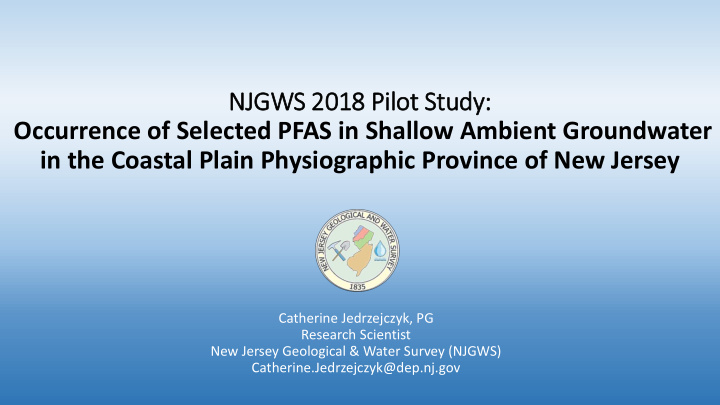



NJGWS 2018 Pil ilot Stu tudy: Occurrence of Selected PFAS in Shallow Ambient Groundwater in the Coastal Plain Physiographic Province of New Jersey Catherine Jedrzejczyk, PG Research Scientist New Jersey Geological & Water Survey (NJGWS) Catherine.Jedrzejczyk@dep.nj.gov
Groundwater sampling for PFAS was conducted by NJGWS in 2018 • Pilot study to research PFAS occurrence in shallow groundwater • Not prompted by any reported issue • Data for informational purposes only • Samples collected between March and June of 2018 • 17 existing monitoring wells (MWs) from the NJ Ambient Groundwater Quality Monitoring Network (AGWQMN) • Sampled using peristaltic pump and HDPE tubing • USGS monitoring well purging method o 3 volume purge with water quality parameter stabilization NJDEP/DWSG/NJGWS - 2
Location • 17 AGWQMN monitoring wells in the Coastal Plain Physiographic Province of NJ • Existing MWs typically sampled by NJGWS in the south NJ sampling set initially selected • Selection not targeted • Other network MWs were substituted if water level was too low or turbidity too high • Pumping depth to water < 25 ft bgs for peristaltic pump to function • Targeted turbidity < 1 NTU (not achieved in all samples) NJDEP/DWSG/NJGWS - 2
General l PFAS-Sampling Considerations Avoid cross-contamination Limit sorption • PFAS can potentially be found in many • Avoid use of LDPE and glass commonly used products in contact with sample • Detection limits are very low • No PFAS-containing sampling equipment • HDPE tubing or supplies recommended • No fluoropolymer pump parts or tubing • Wash hands, clean gloves on before sampling, avoid contact with sample • Lab-provided HDPE or water or inside of bottles polypropylene sample • Collect equipment blanks bottles NJDEP/DWSG/NJGWS - 4
Potential Sources of f PFAS Avoided Limited data available on impact of PFAS- containing products in the sampling environment so most guidance recommends erring on the side of caution This Photo is licensed under CC BY-SA-NC To avoid: Photo is licensed under CC BY-SA-NC • Fluoropolymer-containing sampling Photo is licensed under CC BY-NC-ND equipment and supplies • Water- or stain-resistant clothing and Photo is licensed under CC BY-NC footwear Photo is licensed under CC BY-SA • Personal care products that contain PFAS Photo is licensed under CC BY-SA • Stain-treated vehicle upholstery or carpet • Food wrappers and packaging, especially Photo is licensed under CC BY-NC-ND greaseproof paper products Photo is licensed under CC BY-SA NJDEP/DWSG/NJGWS - 5
Groundwater Sampling for PFAS • No PFAS-containing sampling equipment or supplies used • HDPE tubing and sample bottles to limit sorption • Care was taken to avoid cross-contamination while sampling • Avoided use of potentially PFAS-containing personal care products, clothing, food wrappers • Handwashing in field with PFAS-free water • New gloves donned immediately before sampling and avoided contact with sampled water and inside of sample bottle/cap • Equipment blanks and field blanks were collected NJDEP/DWSG/NJGWS - 6
Laboratory ry Analysis • NJ Department of Health Laboratory • EPA Method 537 rev 1.1 • Determination of Selected Perfluorinated Alkyl Acids (PFAAs) in Drinking Water by Solid Phase Extraction and Liquid Chromatography/Tandem Mass Spectrometry (LC/MS/MS) • Validated and approved by NJDEP Office of Quality Assurance • No approved method for non-potable water at the time of study design • Data for informational purposes only • 14 PFAS analytes: NEtFOSAA PFHxA PFDA NMeFOSAA PFHpA PFUnA PFBS PFOA PFDoA PFHxS PFNA PFTrDA PFOS PFTA NJDEP/DWSG/NJGWS - 7
DRAFT Detections Of the 17 monitoring wells sampled: • 12 (71%) MWs with at least 1 PFAS detection above the Limit of Quantitation (LOQ) • 11 (65%) MWs with multiple PFAS detections NJDEP/DWSG/NJGWS - 8
Detected Compounds Number of MWs Maximum Number of MWs Maximum Number of MW with concentrations Contaminant Compound with detections concentration samples above ≥ 5 ng/L reporting Level (MCL) (above LOQ) detected in ng/L MCL limit (RL) in ng/L PFNA 3 1 8.7 13 0 PFOA 11 9 23.6 14* 4 PFOS 10 4 9.2 13* 0 PFHxS 2 2 18.3 PFHxA 9 6 12.5 PFHpA 4 0 4.9 J PFBS 10 0 3.1 J Notes: 1. Data for informational purposes only. 2. J: Compound detected above limit of quantitation (LOQ) but below RL. Estimated value. 3. * Proposed MCL NJDEP/DWSG/NJGWS - 9
Total PFAS Concentrations NJDEP/DWSG/NJGWS - 10
PFNA NJDEP/DWSG/NJGWS - 11 Data for informational purposes only.
PFOA Data for informational purposes only. NJDEP/DWSG/NJGWS - 12
DRAFT PFOS NJDEP/DWSG/NJGWS - 13 Data for informational purposes only.
• Data shared within NJ DEP • Working with United States Geological Survey (USGS) to develop sampling plan for including PFAS in annual AGWQMN sampling Ongoin ing PFAS-rela lated • Planning to include sampling for PFAS in 2020 sampling event Work at NJG JGWS • 50 monitoring wells anticipated to be sampled in partnership with Bureau of Freshwater and Biological Monitoring and USGS • Modifications to sampling method, analytical method, QA/QC NJDEP/DWSG/NJGWS - 14
Questions? NJGWS -
Recommend
More recommend